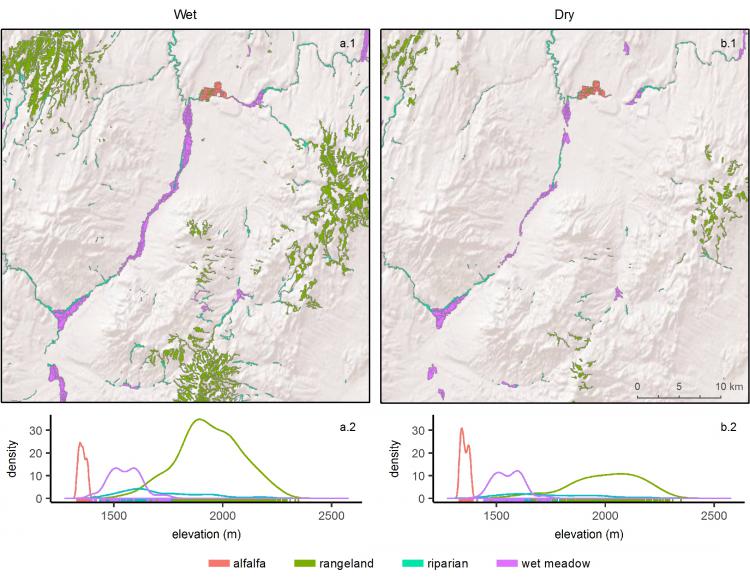The North American semiarid sagebrush biome exhibits considerable climatic complexity driving dynamic spatiotemporal shifts in primary productivity. Greater and Gunnison sage-grouse are adapted to patterns of resource intermittence and rely on stable adult survival supplemented by occasional recruitment pulses when climatic conditions are favorable. Predictions of intensifying water scarcity raise concerns over new demographic bottlenecks impacting sage-grouse populations in drought-sensitive landscapes.
FWS researchers estimated biome-wide mesic resource productivity from 1984 to 2016 using remote sensing to identify patterns of food availability influencing selective pressures on sage-grouse. Productivity was linked to abiotic factors to examine effects of seasonal drought across time, space, and land tenure, with findings partitioned along gradients of ecosystem water balance within the Great Basin, Rocky Mountains, and Great Plains regions. Precipitation was the driver of mesic resource abundance, explaining ≥70% of variance in drought-limited vegetative productivity. Spatiotemporal shifts in vegetation abundance were apparent given biome-wide climatic trends that reduced precipitation below three quarters of normal in 20% of the years. Drought sensitivity structured grouse populations wherein landscapes with the greatest uncertainty in mesic abundance and distribution supported the fewest grouse. Privately owned lands encompassed 40% of sage-grouse range but contained a disproportional 68% of mesic resources, shifting in part the perception of the species’ reliance on public lands.
Regional drought sensitivity acted as ecological minimums to influence differences in landscape carrying capacity across sage-grouse range. The model depictions likely reflect a new normal in water scarcity that could compound impacts of demographic bottlenecks in the Great Basin and Great Plains. Long-term population maintenance depends on a diversity of drought-resistant mesic resources that offset climate-driven variability in vegetative productivity. A holistic public-private lands approach to mesic restoration is needed to offset a deepening risk of water scarcity.
https://map.sagegrouseinitiative.com/ecosystem/mesic-resources?ll=43.47…
https://onlinelibrary.wiley.com/doi/full/10.1002/ece3.4614

Great Basin example: Salmon Falls watershed displaying typical spatiotemporal shifts in mesic site vegetation productivity (Normalized Difference Vegetation Index ≥0.3) occurring during wet (a.1) and dry (b.1) years. These years are representative of third (wet) and first (dry) quartile annual precipitation measures occurring at 107% (a, Q3 = 2009) and 80% (b, Q1 = 2000) of annual percent normal precipitation from 1984-2016. Density plots (a.2, b.2) show relative abundance of vegetation in mesic sites by elevation.

